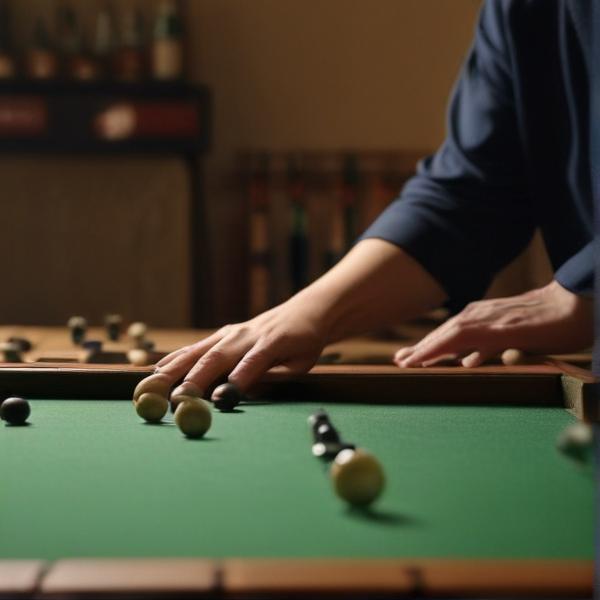基本信息 (Basic Information)
含义与用法 (Meanings & Usage)
中文核心释义 (Core Chinese Meaning): 棋子,棋类游戏,如围棋、象棋等。
英文核心释义 (Core English Meaning): chess piece; board game (such as Go, Chinese chess, etc.)
象形意义 / 为何这么写 (Pictographic Meaning / Writing Rationale)
文言文释义 (Classical Chinese Meaning)
与现代意义相近,主要指棋子或棋类游戏。Similar to modern meaning; mainly refers to chess pieces or board games.
深入学习 (In-depth Study)
字源故事 (Origin Story)
字形演变 (Character Evolution)
常用词语和例句 (Common Words & Examples)
棋手 (chess player; Go player; someone who plays board games)
这位棋手在国际比赛中获得了冠军。
Eng: This chess player won the championship in the international competition.
棋盘 (chessboard; board for playing chess)
他在棋盘上仔细思考下一步棋。
Eng: He carefully considered his next move on the chessboard.
棋子 (chess piece)
请把所有的棋子都收进盒子里。
Eng: Please put all the chess pieces into the box.
象棋 (Chinese chess (xiangqi))
很多老人喜欢下象棋消遣。
Eng: Many elderly people enjoy playing Chinese chess for fun.
相关成语 (Related Idioms)
举棋不定
Meaning: to hesitate; to be unable to make a decision (literally: to hold a chess piece without making a move)
多语言翻译 (核心释义) (Translations (Core Meaning))
- French: échecs; pièce de jeu de société
- German: Schach; Spielfigur
- Spanish: ajedrez; ficha de juego
- Italian: scacchi; pedina da gioco
- Portuguese: xadrez; peça de jogo
- Russian: шахматы; игровая фигура
- Arabic: شطرنج؛ قطعة لعبة لوحية
- Persian: شطرنج؛ مهرههای بازی
- Dutch: schaak; speelstuk
- Polish: szachy; pionek do gry
- Vietnamese: cờ; quân cờ
- Ukrainian: шахи; ігрова фігура
视频学习资源 (Video Learning Resources)
通过以下链接在热门视频网站搜索 "棋" 的更多讲解:
Search for more explanations of "棋" on popular video sites:
- 在 Bilibili.com 搜索 "棋 字源 说文解字" (Search on Bilibili)
- 在 YouTube.com 搜索 "棋 character origin etymology" (Search on YouTube)
网络参考 (Web References for "棋") ()
网络内容摘要 (Web Content Summary):
棋(qí)是汉语中常用字,核心含义为“棋盘”或“棋类游戏”(如围棋、象棋等)。 Qi is a commonly used Chinese character meaning "chessboard" or "board games" (such as weiqi/Go, Chinese chess, etc.).
“棋”字起初见于甲骨文,形体由“木”和“其”组成。“其”象征放有簸箕的几案,整体表示几案上排列成行的木器,这与棋盘的外观有关。从字形演变看,“棋”属于形声字,既有形体意义,也有声旁提示。 The earliest form of "棋" appears in oracle bone script, made up of "木" (wood) and "其" (a phonetic and semantic element suggesting a dustpan on a table). This symbolizes wooden objects arranged in rows—reflecting the appearance of a game board. "棋" is a phono-semantic compound character.
“棋”常用于指各种棋类游戏,如“象棋”(Chinese chess)、“围棋”(Go)。常见的相关词语有:棋盘(chessboard)、棋子(chess piece)、棋手(player),以及成语“棋高一着”(superior by one move)。 "棋" often refers to board games, such as "象棋" (Chinese chess) and "围棋" (Go). Common related words include: 棋盘 (chessboard), 棋子 (piece), 棋手 (player), and the idiom "棋高一着" (superior by one move).
- 注意:“棋”不要与“旗”(qí, flag)混淆,两者字形和含义不同。 Note: Do not confuse "棋" with "旗" (flag); their characters and meanings are different.
棋字形演变字源_汉字「棋」_棋的甲骨文_棋的金文_金文编_甲骨文编
甲骨文字形從木、從廾、 (其)聲,像雙手持箕棄木之形。 篆文則改「 」為「 」,增加「丌」形,並將「木」迻於「 」(其)下,成為從木、其聲之形。 隸書及楷書則又將篆文下形上聲的字形改為左形右聲的結構。在六書中,甲骨文字形屬於形聲兼會意;篆文及隸書、楷書的字形則屬於形聲。
棋(汉语汉字)_百度百科
棋,汉语常用字,读作qí,最早出现于甲骨文,由"木"和"其"构成。"其"字表示几案上有簸箕,整个字的意思是几案上有像簸箕横竖成行条纹的木制品。它指围棋盘,引申表示各种棋。基本信息栏主要参考资料:
更多图片 (棋 More Images) ()
